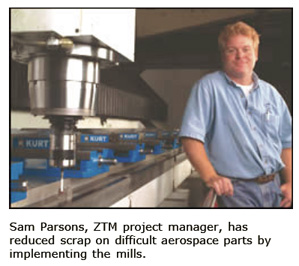When asked to reveal the secret of the company’s success, Brad Julius, founder of ZTM Inc., responds that he follows one rule. “We give our customers what they want, when they want it,” he says.
Less than 20 years ago, Mr. Julius founded ZTM Inc. in his garage with a conventional mill and a vision for the future. Today, the Wichita, Kansas-based company employs more than 80 people, producing products for Tier-1 aerospace companies throughout the world. Two major expansions in 1998 and 2006 account for its modern 92,000-square-foot facility. Another expansion, which is planned for 2008/2009, will add 150,000 square feet to the shop’s current production space.
ZTM strives to be progressive, especially in the areas of manufacturing equipment, part production and process control. To this end, the company has invested in two palletized, railguided vehicle systems, which allow it to produce high-volume, high-quality parts while reducing labor costs, enabling “lightsout” operation and minimizing machine downtime. A third system is planned for 2008.
Techniques and processes developed around high speed, 240-inch Bertsche X-Mill machining centers are also part of the cutting edge ingenuity deployed at ZTM.
When ZTM acquired its first pair of Bertsche high speed, long-travel machines in 1998, thermal compensation was one of the first hurdles it needed to overcome. Long parts can be affected by changes in temperature. In Wichita, temperature extremes and fluctuations are common. Rather than opting for an expensive X-axis laser machine measuring system, the company worked with Bertsche to develop a simple solution. Using macro cycles supplied by the manufacturer, a part probe and a gaging tool that grows with the machine bed, the mills can automatically compensate for machine and part thermal expansion with great accuracy, the company says.
Another challenge during the early days was chip containment and evacuation. The first part that the shop machined on the long-bed mill exceeded the chip handling capacity of the chip conveyor in less than 30 minutes of cutting. Design changes to the machine bed and chip conveyor have solved this problem and have led to design innovations on current X-Mill models, the manufacturer says.
The new mills feature a raised-bed design to improve chip containment. The elevated moving spindle module is mass-reduced and features a feed-force centered design that converts machine servo motions by the shortest path to the tool. This configuration results in high dynamic accuracy, the manufacturer says. In addition, the machines have dual work zones and pneumatically driven doors to protect operators. The “auto open” feature opens the doors at the end of a part cycle so operators can discern when the machine needs attention.
“The Bertsche mills are very accurate,” says Sam Parsons, the ZTM project manager responsible for Bertsche implementations. “They enable us to achieve excellent repeatability when drilling close tolerance holes, as well as holding very close tolerances as we mill wall thicknesses down to 0.020 inch.”
“We bought the X-Mill in October 2006 to run a part family with our second highest scrap rate,” he adds. “After reprogramming and retooling the X-Mill, we have not produced one scrap part from that family.”
The company has taken other steps to maximize the mills’ capabilities, including using standard fixtures that relocate the workpiece without requiring offset changes. To avoid input mistakes, offset data are loading automatically with each program. In addition, the company measures tool offsets with a presetter rather than measuring the tools at the machine. Part probing is used to establish workpiece offsets when drilling close tolerance holes.
With these successes in mind, the company is in the process of applying the same methodology to all of its machines and processes. ZTM concludes that partnering with machine tool builders and using down-home Kansas ingenuity enables it to produce quality parts on time, every time. Serving the Metalworking Industries.
About the Author
This article orginally appeared in Modern Machine Shop, October 2007.Tags : aluminum, composites, high accuracy machining, high volume CNC machining, long bed, stringers

